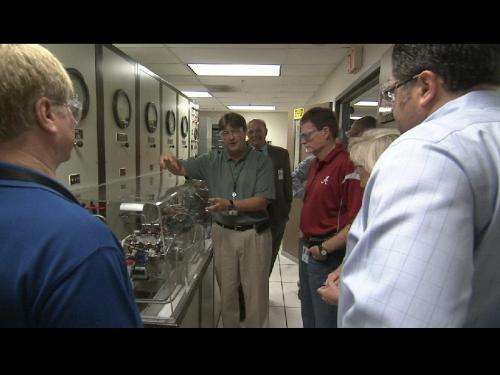Space Launch System providing engine 'brains' with an upgrade

(Phys.org)—America's next heavy-lift rocket needs a strong and reliable engine to launch humans beyond low Earth orbit. That's why engineers with NASA's Space Launch System program, managed at the Marshall Space Flight Center in Huntsville, Ala., will use the proven RS-25, the space shuttle's main engine during its 30-year history, to power the massive rocket's core stage. The RS-25, which was designed and developed with NASA by Pratt & Whitney Rocketdyne of Canoga Park, Calif., is a crucial part to the core stage design, but a few enhancements are planned.
While the RS-25 engines launched 135 missions, it needs a new "brain" to drive the 3.5-ton engine.
"The computer controlling the SSME was manufactured in the early '80s and many parts are now obsolete," said Jeremy Richard, SLS Liquid Engines Office Subsystem manager. "While working on updating the technology, we discovered we could adapt the same controller being used by the new J-2X engine to the RS-25 engine, effectively streamlining the controller and resulting in a cost savings."
The role of an engine controller unit is to allow communication between the vehicle and the engine, sending commands down to the engine and transmitting data back to the vehicle. The controller also provides closed loop management of the engine by regulating thrust and fuel mixture ratio while monitoring the engine's health and status.
"Our long-term objective is to use the same basic hardware design to control multiple engines," Richard said. "With a common physical design and just a few card change outs, we could control the RS-25, J-2X, and future engine designs at less than half the cost of a space shuttle main engine controller."
Engineers with Pratt & Whitney Rocketdyne are hard at work on the J-2X engine control unit in Building 4436 at the Marshall Center. The J-2X will power the upper stage of the evolved heavy-lift rocket, capable of lifting 130 metric tons beyond low Earth orbit.
Meanwhile, in a separate room barely 20 feet away, the same controller with a few minor alterations is undergoing rigorous testing for the RS-25. This room houses equipment to simulate the engine in flight, using real RS-25 actuators, connectors and harnesses.
SLS engineers will spend the coming year fine-tuning the design and testing the controller unit at the Marshall Center. Once they have a proven lab-tested version, the controller will be moved to the Stennis Space Center in Mississippi for hot-fire testing in 2014.
Building on an established infrastructure but with a modern design, the ultimate goal is a universal rocket engine controller.
Watch the video below for a closer look at a recent test of the RS-25 engine controller unit:
Provided by NASA


















